Luxembourg
Introduction
officially Grand Duchy of Luxembourg, French Grand-Duché de Luxembourg, German Grossherzogtum Luxemburg
Luxembourg, flag of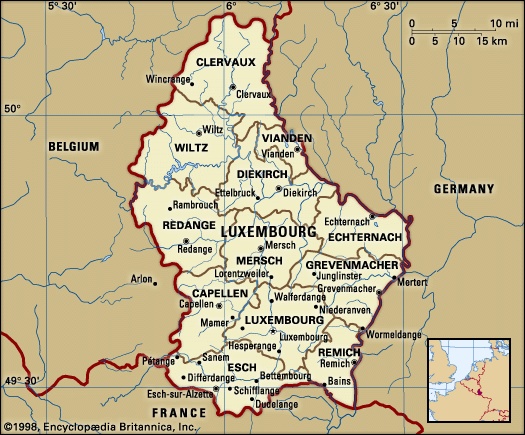 country in northwestern Europe. It is one of the world's smallest countries. It is bordered by Belgium on the west and north, France on the south, and Germany on the northeast and east. Luxembourg has come under the control of many states and ruling houses in its long history, but it has been a separate, if not always autonomous, political unit since the 10th century. The ancient Saxon name of its capital city, Lucilinburhuc (Luxembourg) (“Little Fortress”), symbolized its strategic position as “the Gibraltar of the north,” astride a major military route linking Germanic and Frankish territories.
country in northwestern Europe. It is one of the world's smallest countries. It is bordered by Belgium on the west and north, France on the south, and Germany on the northeast and east. Luxembourg has come under the control of many states and ruling houses in its long history, but it has been a separate, if not always autonomous, political unit since the 10th century. The ancient Saxon name of its capital city, Lucilinburhuc (Luxembourg) (“Little Fortress”), symbolized its strategic position as “the Gibraltar of the north,” astride a major military route linking Germanic and Frankish territories.
 country in northwestern Europe. It is one of the world's smallest countries. It is bordered by Belgium on the west and north, France on the south, and Germany on the northeast and east. Luxembourg has come under the control of many states and ruling houses in its long history, but it has been a separate, if not always autonomous, political unit since the 10th century. The ancient Saxon name of its capital city, Lucilinburhuc (Luxembourg) (“Little Fortress”), symbolized its strategic position as “the Gibraltar of the north,” astride a major military route linking Germanic and Frankish territories.
country in northwestern Europe. It is one of the world's smallest countries. It is bordered by Belgium on the west and north, France on the south, and Germany on the northeast and east. Luxembourg has come under the control of many states and ruling houses in its long history, but it has been a separate, if not always autonomous, political unit since the 10th century. The ancient Saxon name of its capital city, Lucilinburhuc (Luxembourg) (“Little Fortress”), symbolized its strategic position as “the Gibraltar of the north,” astride a major military route linking Germanic and Frankish territories.Luxembourg is a point of contact between the Germanic- and Romance-language communities of Europe, and the grand duchy itself has three official languages: German, French, and Luxembourgian. The peoples of Luxembourg and their languages reflect the grand duchy's common interests and close historical relations with its neighbours. In the 20th century, Luxembourg became a founding member of several international economic organizations. Perhaps most importantly, the grand duchy was an original member of the Benelux Economic Union (1944), which linked its economic life with that of The Netherlands and of Belgium and would subsequently form the core of the European Community (EC).
The land
Relief and soils
 The northern third of Luxembourg, known as the Oesling (Ösling), comprises a corner of the Ardennes Mountains, which lie mainly in southern Belgium. It is a plateau that averages 1,500 feet (450 metres) in elevation and is composed of schists and sandstones. This forested highland region is incised by the deep valleys of a river network organized around the Sûre (or Sauer) River, which runs eastward through north-central Luxembourg before joining the Moselle (or Mosel) River on the border with Germany. The Oesling's forested hills and valleys support the ruins of numerous castles, which are a major attraction for the region's many tourists. The fertility of the relatively thin mountain soils of the region was greatly improved with the introduction in the 1890s of a basic-slag fertilizer, which is obtained as a by-product of the grand duchy's steel industry.
The northern third of Luxembourg, known as the Oesling (Ösling), comprises a corner of the Ardennes Mountains, which lie mainly in southern Belgium. It is a plateau that averages 1,500 feet (450 metres) in elevation and is composed of schists and sandstones. This forested highland region is incised by the deep valleys of a river network organized around the Sûre (or Sauer) River, which runs eastward through north-central Luxembourg before joining the Moselle (or Mosel) River on the border with Germany. The Oesling's forested hills and valleys support the ruins of numerous castles, which are a major attraction for the region's many tourists. The fertility of the relatively thin mountain soils of the region was greatly improved with the introduction in the 1890s of a basic-slag fertilizer, which is obtained as a by-product of the grand duchy's steel industry.The southern two-thirds of Luxembourg is known as the Bon Pays, or Gutland (French and German: “Good Land”). This region has a more varied topography and an average elevation of 800 feet. The Bon Pays is much more densely populated than the Oesling and contains the capital city, Luxembourg, as well as smaller industrial cities such as Esch-sur-Alzette. In the centre of the Bon Pays, the valley of the northward-flowing Alzette River forms an axis around which the nation's economic life is organized. Luxembourg city lies along the Alzette, which joins the Sûre farther north.
In the east-central part of the Bon Pays lies a great beech forest, the Müllerthal, as well as a sandstone area featuring an attractive ruiniform topography. The country's eastern border with Germany is formed (successively from north to south) by the Our, Sûre, and Moselle rivers. The slopes of the Moselle River valley, carved up in chalk and calcareous clay, are covered with vineyards and receive a substantial amount of sunshine, which has earned the area the name of “Little Riviera.” Besides vineyards, the fertile soils of the Moselle (Moselle River) and lower Sûre valleys also support rich pasturelands. Luxembourg's former iron mines are located in the extreme southwest, along the duchy's border with France.
Climate
Luxembourg has a mild climate, with considerable precipitation. The north is slightly colder and more humid than the south. The mean temperatures in Luxembourg city range from 33° F (0.7° C) in January to 63° F (17° C) in July, but in the Oesling both extremes are slightly lower. The Oesling receives more precipitation than the Bon Pays, but the greatest amount, about 40 inches (1,000 millimetres), and the least, about 27 inches, fall in the southwest and southeast, respectively. The sheltered valley of the Moselle River benefits from a gentler and sunnier climate than does the rest of the duchy.
Settlement patterns
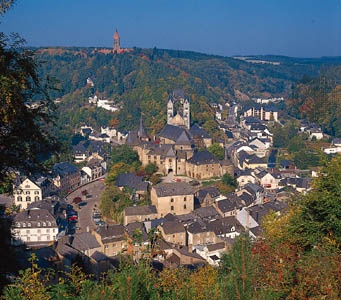 Northern Luxembourg is sparsely populated compared to the heavily urbanized and industrialized south. The north's rural population is clustered in villages of thick-set stone houses with slate roofs. The urban network in the south is dominated by the capital city, Luxembourg, which rises in tiers, with the upper (and older) section of the city separated from the lower-lying suburbs by the gorges of the Alzette and Petrusse rivers. A new quarter housing many European organizations nestles in a picturesque site carved into the river valley's sandstone cliffs. The second-largest city in Luxembourg, Esch-sur-Alzette, lies in the extreme southwest and is a traditional iron-making centre. Its growth, like that of the neighbouring iron and steel centres of Pétange, Differdange, and Dudelange, has slowed since the shrinkage of those industries in western Europe in the late 20th century. The remainder of the nation's population lives in towns and villages of relatively small size. Many of Luxembourg's villages date from ancient Celtic and Roman times or originated in Germanic and Frankish villages after about AD 400. In addition, many medieval castle villages continue to thrive, centuries after the castles themselves fell into ruin.
Northern Luxembourg is sparsely populated compared to the heavily urbanized and industrialized south. The north's rural population is clustered in villages of thick-set stone houses with slate roofs. The urban network in the south is dominated by the capital city, Luxembourg, which rises in tiers, with the upper (and older) section of the city separated from the lower-lying suburbs by the gorges of the Alzette and Petrusse rivers. A new quarter housing many European organizations nestles in a picturesque site carved into the river valley's sandstone cliffs. The second-largest city in Luxembourg, Esch-sur-Alzette, lies in the extreme southwest and is a traditional iron-making centre. Its growth, like that of the neighbouring iron and steel centres of Pétange, Differdange, and Dudelange, has slowed since the shrinkage of those industries in western Europe in the late 20th century. The remainder of the nation's population lives in towns and villages of relatively small size. Many of Luxembourg's villages date from ancient Celtic and Roman times or originated in Germanic and Frankish villages after about AD 400. In addition, many medieval castle villages continue to thrive, centuries after the castles themselves fell into ruin.The people
Luxembourg has been one of the historic crossroads of Europe, and myriad peoples have left their bloodlines as well as their cultural imprints on the grand duchy. The Celts, the Belgic peoples known as the Treveri, the Ligurians and Romans from Italy, and especially the Franks were most influential. The dialect spoken by Luxembourg's native inhabitants is Luxembourgian, or Letzeburgesch, a Moselle-Franconian dialect of German that has been enriched by many French words and phrases. Most Luxembourgers speak French (used for most official purposes) and German (the lingua franca). There is a strong sense of national identity among Luxembourgers despite the prevalence of these foreign influences. Almost all of Luxembourg's native citizens are Roman Catholic, with a small number of Protestants, mainly Lutherans, and Jews.
Luxembourg has a higher proportion of foreigners living within its borders than does any other European country. This is chiefly the result of an extremely low birthrate among native Luxembourgers, which has led to a chronic labour shortage. Fully one-quarter of the total population is of foreign birth and consists mainly of Portuguese, Italians, and other southern Europeans, along with French, Belgians, and Germans. Among the foreign workers are many in the iron and steel industry, and numerous others work in foreign firms and international organizations located in the capital.
The 20th century has also witnessed a continual internal migration away from the countryside to urban areas, and the growth of Luxembourg's service sector at the expense of heavy industry has only accelerated this trend. Luxembourg city in particular continues to attract migrants from the rest of the country because of its vibrant banking and finance sector. The increasing concentration of the population in the southwest has led the government to try to locate some industries in rural areas. About two-thirds of Luxembourg's work force is engaged in trade, government, and other service occupations, while almost one-third of the work force is employed in industry and construction, and the rest in agriculture.
The economy
Luxembourg's economy is notable for its close connections with the rest of Europe, since Luxembourg itself is too small to create a self-sustaining internal market. Luxembourg's prosperity was originally based on the iron and steel industry, which in the 1960s represented as much as 80 percent of the total value of exports. By the late 20th century, however, the nation's economic vigour stemmed chiefly from its involvement in international banking and financial services and in such noncommercial activities as hosting intra-European political activities. The result of this adaptability and cosmopolitanism is a very high standard of living; the Luxembourgers rank in the world second only to the Swiss in their standard of living and their per capita income.
Resources
Luxembourg's natural resources are quite modest. Its agriculture is not particularly prosperous, and its once-copious iron ore deposits had been exhausted by the 1980s. With the exception of water and timber, there are no energy resources. Indeed, Luxembourg has almost nothing that predisposes it to agricultural or industrial development. The roots of its economic growth lie in its use of capital and in the adaptability and ingenuity of its work force rather than in natural resources.
Industry
The production and export of iron (iron processing) and steel have long played major roles in Luxembourg's economy. Steel production was originally based on exploitation of the iron ore deposits extending from Lorraine into the southwestern corner of the grand duchy. This ore has a high phosphorus content, however, and it was not until the introduction of the basic Bessemer process in 1879 that the ore could be used for making steel. Thereafter Luxembourg's metallurgical industries grew and flourished. During the 1970s, however, the worldwide demand for steel slumped, causing the steel industry's portion of Luxembourg's gross domestic product to fall. In response to this crisis, the steel industry was restructured and merged into a single group called ARBED (Aciéries Réunies de Burbach-Eich-Dudelange (ARBED SA)), and further measures aimed at increasing efficiency enabled Luxembourg's steelmakers to maintain their profitability. With the overall decline of steel production, however, Luxembourg's economy has become more dependent on factories owned by American-based and other multinational companies operating in the country. These factories primarily produce motor-vehicle tires, chemicals, and fabricated metals.
Luxembourg had become an international financial centre and a home to more than 160 banks by the late 20th century. It owes this position to a number of factors, perhaps chief of which is the government's own farsighted policies. In 1929 the government began to encourage the registering in Luxembourg of holding companies; these large corporations can control a number of subsidiary companies but are heavily taxed in many countries of the world. The liberal tax climate produced by the new policy led many industrial and financial corporations to maintain offices, often as their European headquarters, in Luxembourg city. The main offices of the European Investment Bank are there, as are the representatives of many banking institutions from around the world who keep in contact with the European Community (EC). Luxembourg city is also one of the capitals of the EC and as such is home to the European Court of Justice and several major EC administrative offices.
Agriculture
The agricultural resources of Luxembourg are quite modest. With the exception of livestock products, surpluses are scarce, and marginal soils in many parts of the country hinder abundant harvests. Most farming is mixed and includes both animal raising and gardening. Livestock and their by-products account for the bulk of agricultural production, with cattle raising having gained in importance at the expense of pig and sheep raising. Wheat, barley, and other cereal grains are the next most important products, followed by root vegetables. More than three-quarters of the country's farms are smaller than 200 acres (50 hectares). The vineyards along the Moselle River produce some excellent wines.
International trade
Luxembourg's overall balance of payments is strongly positive, mostly because of the country's thriving financial sector. Most of the grand duchy's merchandise trade takes place with EC countries, and especially its three neighbours—Germany, Belgium, and France, which together receive about 60 percent of Luxembourg's exports and provide about 80 percent of its imports.
Energy
Luxembourg meets most of its energy needs with imports. Its only domestic source of power is the hydroelectricity obtained from several dams on its rivers.
Transportation
Luxembourg's internal road system is not extensive but is well maintained, and several highways link the country with its neighbours. A port at Mertert on the canalized Moselle River connects the grand duchy with the Rhine waterway system and provides it with an avenue for the international movement of goods.
The government has operated the nation's railroads since World War II. They are modern, electrified, and mostly double-tracked. A major portion of international transportation to and from Luxembourg is by train, and the country is connected with its neighbours by a large number of lines. Findel Airport outside Luxembourg city has become a major European air terminal served by the lines of many countries. Luxair is the national airline.
Communications
Luxembourg's advanced telecommunications system provides it with close links both to EC countries and to other financial partners around the world, including Japan and the United States.
Administration and social conditions
Government
The grand duchy is a constitutional monarchy with hereditary succession. Executive power authority lies with the grand duke, who appoints the prime minister. The powers of the grand duke are primarily formal, however. Actual executive power lies with the prime minister and his ministerial council, or Cabinet, who are responsible to the Chamber of Deputies. The members of this legislative assembly are elected by popular vote to five-year terms. Voting by all adult citizens, begun in 1919, is compulsory. Legislative elections have usually given rise to coalition governments formed alternatively by two of the three major parties: the Christian Social Party, the Socialist Workers' Party, and the Democratic Party. In addition, a Council of State named by the grand duke functions as an advisory body. It is consulted on all draft legislation, advises the grand duke on administrative affairs, and serves as a supreme court in case of administrative disputes.
There are also three advisory bodies that are consulted before the passage of legislation affecting their particular area of the national life. The first of these consists of six confederations, three of which represent employers (commerce, guilds, and farmers) and three of which represent labour (workers, private employees, and civil servants). The second advisory group, the Social and Economic Council, has become a major committee for the examination of all projects. The third, the Immigration Council, advises the government on problems involving housing and the political rights of immigrants.
Justice is in the hands of magistrates appointed for life by the grand duke, the final appeal lying with the Superior Court of Justice. In the criminal court of assizes, six magistrates sit as jury as well as judge. Luxembourg is a member of the North Atlantic Treaty Organization (NATO) and has a small volunteer army. There is also a small paramilitary gendarmerie.
Luxembourg is divided administratively into three districts, each of which is headed by a commissioner appointed by the central government. Each district is in turn divided into cantons and subdivided into communes, or municipalities. Public works, health, and education are among the responsibilities of the communes, each of which is governed by an elected council and a mayor. These bodies also maintain liaison with the central government and act as its local agents.
Health and welfare
After World War I a broad system of social security and health services was introduced in Luxembourg to ensure maximum welfare protection to each citizen. Sickness benefits, in which patients pay only a small part of medical costs, as well as birth, family, and unemployment payments, are included in the plans. Housing conditions are generally comparable to those found in other western European countries. There has been some difficulty, however, in assimilating the many thousands of foreign workers and their families.
Education
Education is compulsory from age 6 to 15. The educational system offers a mix of primary and secondary schools run by state and local governments and by religious institutions. Considerable emphasis is laid on language studies. Instruction is initially given in German, and French is added in the second year. French completely replaces German in the classroom at the secondary level. There are no four-year universities in the grand duchy, so many young Luxembourgers obtain their higher education abroad. Luxembourg city does, however, have a campus that offers first-year university studies.
Cultural life
The major cultural institution of Luxembourg is the Grand Ducal Institute, which has sections devoted to history, science, medicine, languages and folklore, arts and literature, and moral and political sciences. It functions as an active promoter of the arts, humanities, and general culture rather than as a conservator. The National Museum of History and Art has collections on the fine and industrial arts and on the history of Luxembourg. There is considerable public use of the National Library, the National Archives, and the Music Conservatory of the City of Luxembourg. The grand duchy also maintains cultural agreements with several European and other nations that provide it with the finest in the musical and theatrical arts. The Grand Orchestra of Radiotelevision Luxembourg is considered outstanding. There is an extensive market in Luxembourg city for works of painting and sculpture, both traditional and modern. The grand duchy's architectural heritage extends through practically the entire span of Europe's recorded history, from ancient Gallo-Roman villas to medieval castles, Gothic and Baroque churches, and contemporary buildings.
A small publishing industry exists, printing literary works in French, German, and Luxembourgian. The grand duchy's newspapers express diverse political points of view—conservative, liberal, socialist, and communist. Luxembourg's influence is felt far beyond its borders through the medium of Radiotelevision Luxembourg (RTL), a privately owned broadcasting company that transmits radio programs in five languages and television programs in two (French and German). RTL has a total European audience numbering as many as eight million persons. The government operates all postal and telegraph services in Luxembourg and has some control in the corporation that runs RTL.
History
Ancient and medieval periods
The earliest human remains found in present-day Luxembourg date from about 5140 BC, but little is known about the people who first populated the area. Two Belgic tribes, the Treveri and Mediomatrici, inhabited the country from about 450 BC until the Roman conquest of 53 BC. The occupation of the country by the Franks (Frank) in the 5th century AD marked the beginning of the Middle Ages in the locality. St. Willibrord (Willibrord, Saint) played a very important role in the area's Christianization in the late 7th century. He founded the Benedictine abbey of Echternach, which became an important cultural centre for the region.
The area successively formed part of the Frankish kingdom of Austrasia, of the Holy Roman Empire under Charlemagne and Louis I (the Pious), and then of the kingdom of Lotharingia. Luxembourg became an independent entity in 963, when Siegfried, Count de Ardennes, exchanged his lands for a small but strategically placed Roman castle lying along the Alzette River. This castle became the cradle of Luxembourg, whose name is itself derived from that of the castle, Lucilinburhuc (“Little Fortress”). Siegfried's successors enlarged their possessions by conquests, treaties, marriages, and inheritances. About 1060 Conrad, a descendant of Siegfried, became the first to take the title of count of Luxembourg. Conrad's great-granddaughter, Countess Ermesinde, was a notable ruler whose great-grandson, Henry IV, became Holy Roman emperor as Henry VII in 1308. This Luxembourg dynasty was continued on the imperial throne in the persons of Charles IV, Wenceslas, and Sigismund. In 1354 the emperor Charles IV made the county a duchy. In 1443 Elizabeth of Görlitz, duchess of Luxembourg and niece of the Holy Roman emperor Sigismund, was forced to cede the duchy to Philip III (the Good), duke of Burgundy.
Habsburg (Habsburg, House of) and French domination
Along with the rest of the Burgundian inheritance, the duchy of Luxembourg passed to the Habsburgs in 1477. The division of the Habsburg territories in 1555–56 following Emperor Charles V's abdication put the duchy in the possession of the Spanish Habsburgs. In the revolt of the Low Countries against Philip II of Spain, Luxembourg took no part; it was to remain with what is now Belgium as part of the Spanish Netherlands. (For more specific information about the period, see The Netherlands (Netherlands, The).)
The duchy was able to remain aloof from the Thirty Years' War (1618–48) for a time, but in 1635, when France became involved, a period of disaster began in Luxembourg, which was wracked by war, famine, and epidemics. Moreover, the war did not end for Luxembourg with the Peace of Westphalia in 1648, but only with the Treaty of the Pyrenees in 1659. In 1679 France under Louis XIV began to conquer parts of the duchy, and in 1684 the conquest was completed with the capture of Luxembourg city. France restored Luxembourg to Spain in 1697, however, under the terms of the Treaties of Rijswijk. At the conclusion of the War of the Spanish Succession, by the treaties of Utrecht and Rastatt (1713–14), Luxembourg (along with Belgium) passed from the Spanish to the Austrian Habsburgs.
In 1795, six years after the beginning of the French Revolution, Luxembourg came under the rule of the French again. The old duchy was divided among three départements, the constitution of the Directory was imposed, and a modern state bureaucracy was introduced. The Luxembourg peasantry was hostile toward the French government's anticlerical measures, however, and the introduction of compulsory military service in France in 1798 provoked a rebellion (the Klëppelkrieg) in Luxembourg that was brutally suppressed.
Personal union with The Netherlands
French domination ended with the fall of Napoleon in 1814, and the Allied powers decided the future of Luxembourg at the Congress of Vienna in 1815. The Congress raised Luxembourg to the status of a grand duchy and gave it to William I, prince of Orange-Nassau and king of the Netherlands. William obtained a Luxembourg that was considerably diminished, since those of its districts lying east of the Our, Sûre, and Moselle rivers had been ceded to Prussia. The status of the grand duchy during this period was complex: Luxembourg had the legal position of an independent state and was united with The Netherlands only because it was a personal possession of William I. But Luxembourg was also included within the German Confederation, and a Prussian military garrison was housed in the capital city.
The standard of living of Luxembourg's citizens deteriorated during this period. Under Austrian rule, and especially from 1735 on, the duchy had experienced an economic expansion. From 1816–17 on, however, William I ignored the duchy's sovereignty, treating Luxembourg as a conquered country and subjecting it to heavy taxes. Consequently, it was not surprising that Luxembourg supported the Belgian revolution against William in 1830, and, in October of that year, the Belgian government announced that the grand duchy was a part of Belgium, while William still claimed the duchy as his own. In 1831 the Great Powers (France, Britain, Prussia, Russia, and Austria) decided that Luxembourg had to remain in William I's possession and form part of the German Confederation. Moreover, the Great Powers allotted the French-speaking part of the duchy to Belgium (in which it became a province called Luxembourg), while William I was allowed to retain the Luxembourgian-speaking part. Belgium accepted this arrangement, but William I rejected it, only to subsequently accede to the arrangement in 1839. From that year until 1867, the duchy was administered autonomously from The Netherlands.
Independent Luxembourg
William I negotiated a customs union for Luxembourg with Prussia, and his successor, William II, ratified this treaty in 1842. Against its own will, Luxembourg had thus entered into the Prussian-led Zollverein, or Customs Union, but the grand duchy soon realized the advantages of this economic union. Luxembourg subsequently developed from an agricultural country into an industrial one. Its road network was extended and improved, and two railway companies were begun that formed the basis for the national railway company founded in 1946.
The restricted constitution that William II enacted for Luxembourg in 1841 did not meet the political expectations of its citizens. The Revolution of 1848 in Paris had its influence on the grand duchy, and William II that year enacted a new and more liberal constitution, which was in turn replaced by another constitution in 1856. In 1866 the German Confederation was dissolved, and Luxembourg became an entirely sovereign nation, though the Prussian garrison remained in the capital. Napoleon III of France then tried to purchase the grand duchy from William III. The two rulers had already agreed on the sum of five million florins when William III backed out because the Prussian chancellor, Otto von Bismarck, disapproved of the sale. The Great Powers soon came to a compromise (London; May 11, 1867): Prussia had to withdraw its garrison from the capital, the fort would be dismantled, and Luxembourg would become an independent nation. The grand duchy's perpetual neutrality was guaranteed by the Great Powers, and its sovereignty was vested in the house of Nassau.
On the death of William III of The Netherlands in 1890 without a male heir, the grand duchy passed to Adolf, duke of Nassau (d. 1905), who was succeeded by his son William (d. 1912). Neither Adolf nor William interfered much in Luxembourg's government, but William's daughter, the grand duchess Marie Adélaïde, was more assertive and eventually became highly unpopular with the people. In 1914 the neutrality of Luxembourg was violated by Germany, which occupied the grand duchy until the Armistice of 1918. During the war, Marie Adélaïde had tolerated the illegal German occupation, for which she was criticized by the Allied powers after the liberation. Marie Adélaïde was forced to abdicate in favour of her sister Charlotte in 1919. In a referendum a few months later, the public voted overwhelmingly against the establishment of a republic and in favour of retaining Charlotte as grand duchess.
In December 1918 the Allied powers had forced Luxembourg to put an end to its customs union with Germany. For the grand duchy this meant the loss of its best customer (for cast iron and steel) as well as its main supplier of coal. Luxembourg urgently needed a new economic partner, and, though the people preferred an economic union with France, the grand duchy was forced to negotiate with Belgium, since France declared itself uninterested in such a union. The Belgium-Luxembourg Economic Union (BLEU) was established in 1921 and provided for a customs and monetary union between the two countries. The economic climate in Luxembourg remained rather dreary during the interwar period though.
In May 1940 the German army invaded and occupied Luxembourg for the second time; however, this time the government refused to collaborate and, together with the grand duchess, went into exile. Luxembourg was placed under German rule, and the French language was banned.
After Luxembourg's liberation in September 1944, it took part in the new international organizations being formed by the victorious Allies, including the United Nations. Luxembourg also joined the new Benelux Economic Union (1944) formed between Belgium, The Netherlands, and itself. By taking part in the Brussels Treaty of 1948 and in the formation of NATO in 1949, Luxembourg abandoned its perpetual neutrality. The country improved its economic situation by obtaining a sound position within the European Coal and Steel Community (1952) and within the European Economic Community (1957; later the European Community). Prince Jean, Charlotte's son, was installed as lieutenant-représentant of Charlotte in 1961, and he inherited the throne in 1964 upon his mother's abdication.
When the European Union (EU) was created in 1993, Luxembourg assumed an active role. EU administrative offices were sited in the country, and Luxembourgers such as prime ministers Jacques Santer and Jean-Claude Juncker played especially prominent roles in the EU. At the time the EU was formed, non-citizens made up more than half of the workforce of Luxembourg. By the end of the 20th century, the country had gained a reputation as a centre for private banking and financial services (particularly mutual fund investments), media and satellite broadcasting, and electronic commerce. The economy remained robust through the turn of the century, when Luxembourg claimed the world's highest standard of living (highest gross domestic product per capita). In 2000, at age 79, Grand Duke Jean formally abdicated as chief of state and was replaced by his son, Crown Prince Henri.
Ed.
Additional Reading
An introduction to the country is provided by P. Margue et al., Luxembourg (1984), in French, a well-illustrated work covering history, politics, ethnography, language and literature, natural history, and economy. Studies of the geography and economy of Luxembourg include J.M. Gehring, Le Luxembourg: un espace ouvert de l'Europe rhénane (1977); Paul Weber, Histoire de l'économie luxembourgeoise (1950); and Raymond Kirsch, La Croissance de l'économie luxembourgeoise (1971). Visual presentations of the land and of data on the country may be found in Guy Schmit and Bernd Wiese, Luxemburg in Karte und Luftbild (1980), maps and aerial photos with text in German and French; and Ministère de l'Éducation Nationale, Atlas du Luxembourg (1971). Works focusing on Luxembourg's history include N. Van Werveke, Kulturgeschichte des Luxemburger Landes, 2 vol. in 1 (1923–26); Charles J.P.A. Herchen, History of the Grand Duchy of Luxemburg (1950; originally published in French, 5th rev. ed. by N. Margue and J. Meyers, 1947); E. Donckel, Die Kirche in Luxemburg von den Anfängen bis zur Gegenwart (1950); Paul Weber, Histoire du Grand-Duché de Luxembourg, 4th ed. (1961); Manuel d'histoire luxembourgeoise, 4 vol. (1973–77); James Newcomer, The Grand Duchy of Luxembourg: The Evolution of Nationhood, 963 AD to 1983 (1984); and Gilbert Trausch, Le Luxembourg: emergence d'un état et d'une nation (1989). For further resources see Carlo Hury and Jules Christophory (comps.), Luxembourg (1981), a bibliography.
Luxembourg
also called Letzeburg,

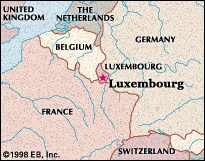
city and capital of Luxembourg, in the south-central part of the country. Luxembourg city is situated on a sandstone plateau into which the Alzette River and its tributary, the Petrusse, have cut deep, winding ravines. Within a loop of the Alzette, a rocky promontory called the Bock (Bouc) forms a natural defensive position where the Romans (ancient Rome) and later the Franks (Frank) built a fort, around which the medieval town developed. The purchase of this castle in AD 963 by Siegfried, Count of Ardennes, marked the beginning of Luxembourg as an independent entity. The castle's old name, Lucilinburhuc (“Little Fortress”), is the origin of the name Luxembourg.
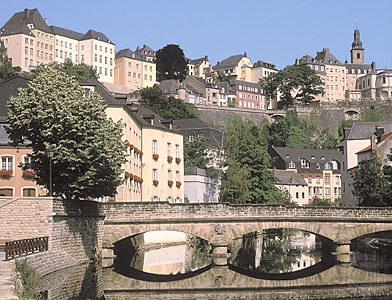 The old town consists of Luxembourg Castle's surviving fortifications, the Grand Ducal Palace, Notre Dame Cathedral, and other historic buildings. The city eventually spread westward, and the suburbs of Grund, Clausen, and Pfaffenthal developed in lower-lying sections across the Alzette from the old town. These sections are linked by several bridges.
The old town consists of Luxembourg Castle's surviving fortifications, the Grand Ducal Palace, Notre Dame Cathedral, and other historic buildings. The city eventually spread westward, and the suburbs of Grund, Clausen, and Pfaffenthal developed in lower-lying sections across the Alzette from the old town. These sections are linked by several bridges.Over a 400-year period, Luxembourg Castle (Château de Luxembourg) was repeatedly attacked and rebuilt by the Spaniards, Austrians, French, and Dutch, successively, to become the strongest fortress in Europe after Gibraltar. One such reinforcement was undertaken by the French military engineer Sébastien Le Prestre de Vauban (Vauban, Sébastien Le Prestre de), who redesigned the city's defensive fortifications after having orchestrated its siege in 1684 in the service of Louis XIV.
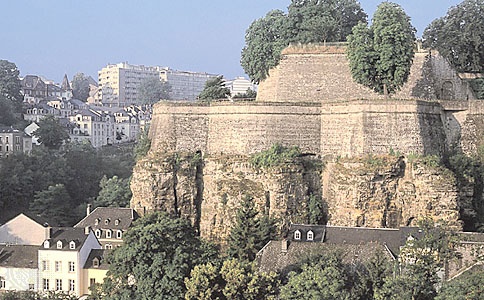 From after the Congress of Vienna (Vienna, Congress of) (1815) to 1866, the fortress was garrisoned by the Prussians as a bulwark of the German Confederation. With the Treaty of London, in 1867, Luxembourg was declared neutral, and the fortress, containing 15 miles (24 km) of casements, three battlements with 24 forts, and an extensive (10-acre 【4-hectare】) area of military barracks, was largely dismantled, an operation that took 16 years. Today visitors can tour the remaining 7 miles (11 km) of casements or view the modern city below from the Chemin de la Corniche, a promontory built atop the old town wall.
From after the Congress of Vienna (Vienna, Congress of) (1815) to 1866, the fortress was garrisoned by the Prussians as a bulwark of the German Confederation. With the Treaty of London, in 1867, Luxembourg was declared neutral, and the fortress, containing 15 miles (24 km) of casements, three battlements with 24 forts, and an extensive (10-acre 【4-hectare】) area of military barracks, was largely dismantled, an operation that took 16 years. Today visitors can tour the remaining 7 miles (11 km) of casements or view the modern city below from the Chemin de la Corniche, a promontory built atop the old town wall.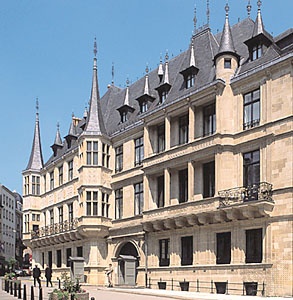 The Grand Ducal Palace (Palais Grand-Ducal) is home to the royal family, heirs of William I (1772–1843), king of The Netherlands and grand duke of Luxembourg (1815–40). The palace dates from 1572, and later additions were made in 1895. After renovations were completed in the 1990s, portions of the palace were opened to the public.
The Grand Ducal Palace (Palais Grand-Ducal) is home to the royal family, heirs of William I (1772–1843), king of The Netherlands and grand duke of Luxembourg (1815–40). The palace dates from 1572, and later additions were made in 1895. After renovations were completed in the 1990s, portions of the palace were opened to the public.Notre Dame Cathedral (Cathédrale Notre-Dame), a Gothic-style church built by Jesuits in 1613, contains the tomb of John the Blind (John), king of Bohemia and count of Luxembourg from 1310 to 1346. Several members of the royal family and noted bishops are buried in the crypt.
The heart of the old town is the Fish Market (Marché-aux-Poissons), around which stand several 17th- and 18th-century buildings, including the mansion housing the Luxembourg National Museum (National Museum of History and Art). Um Bock, a 13th-century building and the city's oldest, is also located at the Fish Market. Among the city's other cultural institutions are the Jean-Pierre Pescatore Museum (1966) of fine arts and the History Museum of the City of Luxembourg (1996). At the town of Hamm 4 miles (6 km) to the east is a World War II military cemetery with the graves of more than 5,000 U.S. soldiers, including those of Brigadier General Edward Betts and General George S. Patton, Jr. (Patton, George Smith)
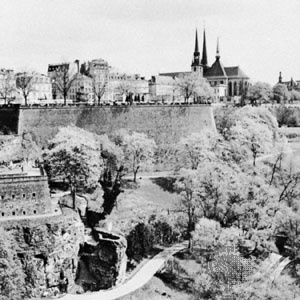 Luxembourg has long been a major road and railway hub. In the 20th century the city became a thriving financial centre owing to banking laws that keep investors' identities confidential and allow the accounts of foreign nationals to earn interest tax-free. Luxembourg is the seat of the European Investment Bank, the European Court of Justice, and several other administrative offices of the European Union. In 1994 the old town was added to UNESCO's World Heritage List (World Heritage site). Pop. (1991) 75,377; (1997 est.) 78,300.
Luxembourg has long been a major road and railway hub. In the 20th century the city became a thriving financial centre owing to banking laws that keep investors' identities confidential and allow the accounts of foreign nationals to earn interest tax-free. Luxembourg is the seat of the European Investment Bank, the European Court of Justice, and several other administrative offices of the European Union. In 1994 the old town was added to UNESCO's World Heritage List (World Heritage site). Pop. (1991) 75,377; (1997 est.) 78,300.- Benoit Mandelbrot
- Benoit, Peter
- Ben Okri
- Benoni
- Benozzo Gozzoli
- Benoît-Constant Coquelin
- Benoît de Sainte-Maure
- Benoît Fourneyron
- Ben Rinnes
- Ben R. Mottelson
- Ben R. Rich
- Benserade, Isaac de
- Ben Shahn
- Ben Slimane
- Benson, Edward White
- Benson, E.F.
- Benson, Sir Frank
- Bent, Charles
- Benten
- bent grass
- Bentham, George
- Bentham, Jeremy
- Bentham, Sir Samuel
- benthos
- Ben Thuy